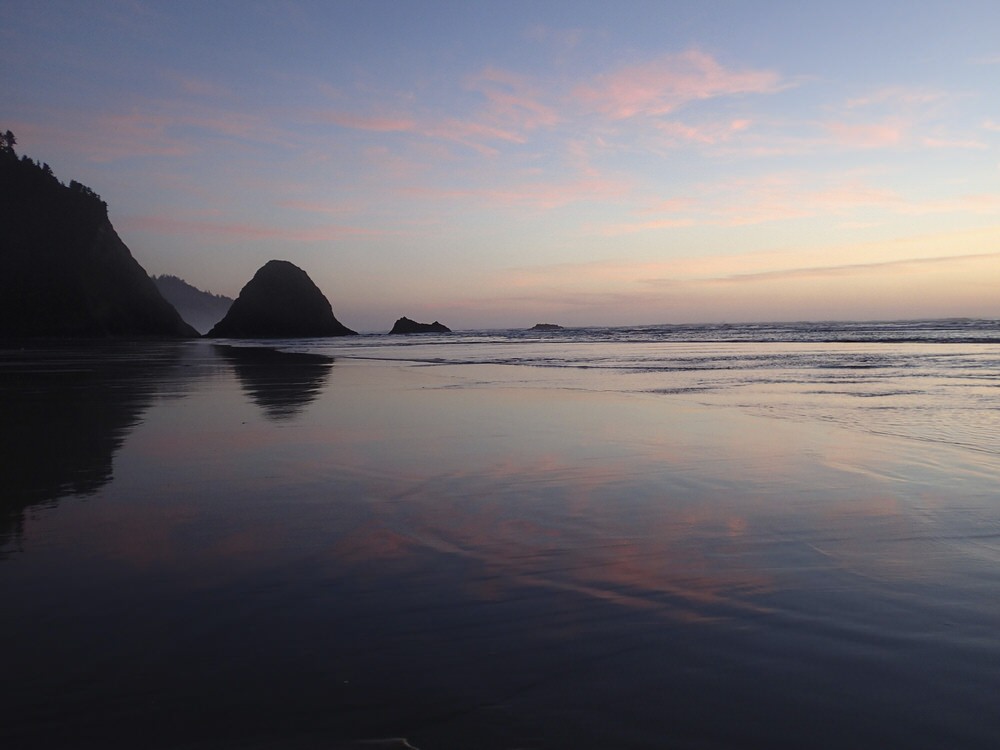When a razor clam senses danger, it doesn't hang around to see what's going to happen, it gets the hell out. With limited resources at its disposal — no claws, teeth... limbs — this means digging with its body, and digging fast.
The Oregon Coast is bursting with edibles this time of year. And while harvesting is a chase in the case of the clam, for most creatures, it's simply a matter of showing up and looking around.
To experience "living off the land" without the trauma of killing something furry, Donnie and I spent a recent weekend hunting things that couldn't move, didn't bite and weren't going to wrack me with sorrow as I plucked them from their habitats and carried them off to the kitchen — i.e. clams, mushrooms and mussels.
We were surprisingly successful, given neither of us has a ton of experience, which was fortunate for our dinner menu.
RAZOR CLAMS Equipped with $7 shellfish permits from the Oregon Department of Fish and Wildlife, rubber gardening gloves and knee-high galoshes, we waded through low tide south of Cannon Beach, pounding the sand with the handles of our shovels to incite the clams to action.
When we glimpsed a "show," or the dimple or doughnut shape that appears on the surface of the sand when a clam retracts its neck and starts to dig, we flipped our shovels blade-down and tried to intercept it before it escaped.
Though my technique needs some refining, Donnie has it down. Within a split second of seeing the sign, he'd sink his shovel into the sand, lever it to open the earth, then plunge his entire arm into the hole to keep digging with his hand. Even after he overtook the creatures, blocking their escape route a couple feet beneath the earth, they'd try to slip through his fingers and escape.
Donnie vs. the clam: DONNIE WINS!
Donnie caught five clams. I got distracted by the sunset.
Layers: yellow, blue, yellow
The catch
Admittedly, clams do not look appetizing in the kitchen sink. But they do taste amazing once you blanch them, remove their shells, batter them and fry them up.
MUSHROOMS
We stalked chanterelle mushrooms near a 55-foot waterfall over a jagged basalt cliff in Tillamook State Forest. The pale orange trumpet-shaped mushrooms, which have long ridges on the undersides of their caps, thrive on north-facing hills in second-growth forests near old stumps and fallen trees (they're particular). They tend to show up in abundance a couple days after a good rain and, we decided, are most plentiful on Thursdays, after they've had time to regenerate from weekend foraging excursions.
Fern creature
We hiked a mile or so from the trailhead — not far — before scrambling up a fern-covered hillside, keeping a lookout for orange bursts amidst the browns and greens. Once we spotted the delicate forms, we plucked them from the ground, sliced off their bases and added them to our bag o' goodies. Since they often grow in colonies, we learned that when you see one, you look for more.
We resolved to stop harvesting once we'd gathered as many as we could eat in one or two meals, but we found resisting the beautifully formed fungi incredibly difficult. Just one more. And this one too! Oh, and that one over there; it's the most perfect of all — GAH!!
Back at our cabin in Arch Cape, we brushed the chanterelles clean, then sautéed them in butter, baked them in the oven and served them with pork, spinach and garlic over orzo. The next morning, we added them to an egg scramble for breakfast. Yum.
MUSSELS
As the setting sun cast Nehalem Bay in pinks and purples, we clambered down the rocks buttressing the jetty to find Dinner Ingredient Numéro Trois. Out in plain sight and incapable of moving, the mussels didn't have a chance; harvesting them was easy as picking cherry tomatoes from our prolific plant at home. We cracked the creatures from the rocks, targeting those larger than our thumbs and with the fewest barnacles attached. (You've gotta be careful though: since mussels filter whatever comes their way, no matter how toxic, they can be dangerous to eat during certain times of the year. You can check their status by calling the state's shellfish safety hotline before you hit the rocks.)
Afloat by the jetty
We prepared the mussels the simplest way possible, using only their natural salty flavor as seasoning. We boiled them in a frying pan until their shells popped open, then scooped them out and ate them up.
OTHER SWEET FINDS
Oh and also: we harvested cups of coffee and a growler of Ankle-Buster Ale from Lincoln City's Pelican Brewery, where both the food and drink are worth the trip.
Me with my coffee score. Weekend complete.














